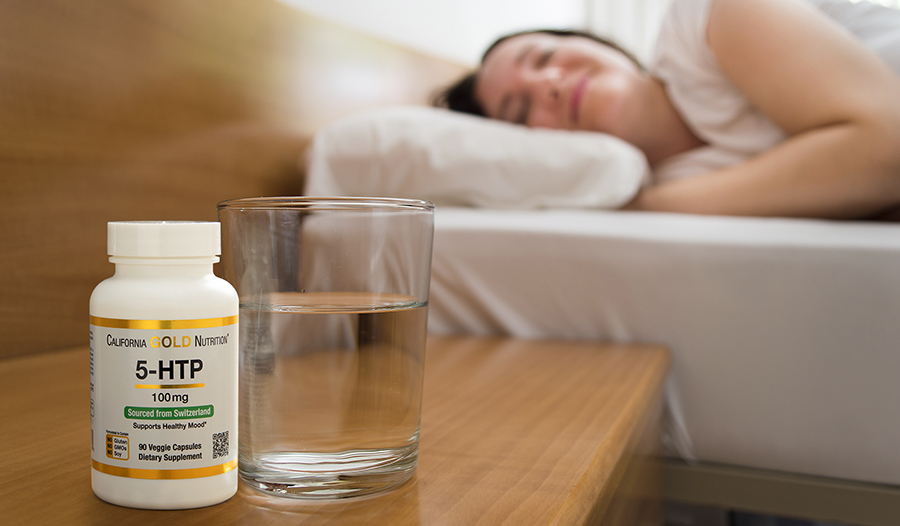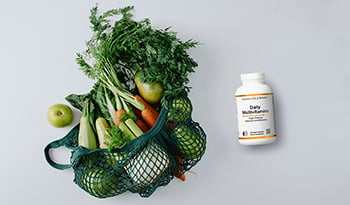We Make Melatonin From Serotonin: Here’s Why That Matters
DISCLAIMER:This blog does not intend to provide diagnosis...
- In this article:
- Melatonin Is Made From Serotonin
- What Is Serotonin?
- Sleep Hygiene to Promote Melatonin Production
- Takeaway

By far one of the most common conversations my clients and I have is about sleep and how it’s affected by light, time, meals, movement, and, more importantly, our moods. Often, my clients are shocked to learn about the connection between serotonin and melatonin, and why it matters for sleep. In this article, we’ll cover both of these neurohormones and how you can make them naturally or take them as a supplement to help you get your best night’s rest.
Melatonin Is Made From Serotonin
Melatonin, the “sleep, and antioxidant hormone,” is actually made from serotonin, the neurohormone that helps us feel happy and calm.
If you’re surprised to hear this, you’re not alone!
Many of my clients are shocked to hear that this relationship exists. Their first question usually is, “So, does that mean that if I don’t have enough serotonin, I can’t make melatonin?”
The answer is, yes! This is why it’s so important to optimize serotonin production if you’re trying to optimize melatonin production and sleep.
The truth is, you don’t have to take medications or supplements to make either of these chemicals if you know how to use food and lifestyle to your advantage. If you do take supplements to ensure you’re getting enough serotonin and melatonin, there’s a right and a wrong way to do it.
What Is Melatonin and How Is It Made?
Melatonin is a neurohormone made by the pineal gland that has a few main functions, including acting as a powerful antioxidant and anti-inflammatory compound that may be linked to good physical recovery and longevity. Melatonin also helps humans biologically manage the changing of the seasons and can even help treat jet lag. It is also absolutely essential for getting a good night’s sleep.
The pineal gland, where melatonin is made, is located in both of the brain’s hemispheres. Its primary role in mammals is to regulate the sleep/wake cycle.
The pineal gland is stimulated by photoreceptive cells in your retina. When you “see” light, it activates an electrical chain of events from your eyes to your spinal cord and on to your brain to create your circadian rhythm. The pineal gland works in conjunction with your circadian rhythm to produce chemicals that either allow you to stay awake and alert or calm down and get quality rest.
Many people don’t realize that your circadian rhythm is literally linked to your environment, and it modifies itself based on temperature and the availability of light.
Inside the pineal gland is where the magic happens. (Just kidding, it’s not magic—it’s science!) The pineal gland takes the hormone serotonin and uses enzymes to turn it into N-Acetylserotonin. Those enzymes are stimulated by darkness. The conversion cannot take place if your eyes are exposed to light.
If it continues to stay dark, N-Acetylserotonin is converted into melatonin, which helps induce sleep. The more serotonin you have, the more melatonin your brain can make as long as conditions are right.
The takeaway here is that if you have enough serotonin in your brain, you can use dark lighting to turn it into melatonin, which will help you sleep.
What Is Serotonin?
Serotonin is a neurohormone that is essential to the brain’s healthy functioning. Over the past few years, serotonin has become a “popular” hormone because of the prevalence of Selective Serotonin Reuptake Inhibitors (SSRIs), which are commonly prescribed for depression. These drugs speak to the importance of serotonin in balancing and moderating our moods.
Serotonin is a hormone made from the amino acid tryptophan and vitamins B12, folate, and BH4 (tetrahydrobiopterin, which is made using folate and vitamin B12).
You can get some of these vitamins easily through your diet. For example, folate is abundant in black-eyed peas, spinach, and beef liver, and B12 is commonly found in beef liver, various types of seafood, nutritional yeast, milk, and yogurt. Tryptophan, an amino acid, is found in foods that are high in protein. If you are a vegan or vegetarian, you may benefit from boosting your intake of protein-rich foods to ensure adequate tryptophan intake.
You can take L-tryptophan as a dietary supplement, or better yet a form of tryptophan known as 5-hydroxytryptophan or 5-HTP. 5-HTP is one step closer to serotonin than L-tryptophan. Clinical research shows 5-HTP produces more efficient conversion to serotonin and better results in boosting mood and improving sleep.
If you choose to supplement, make sure to check with your doctor first, as 5-HTP can interact with many medications and even cause serotonin syndrome.
What Does Serotonin Do?
As noted earlier, serotonin’s primary job is moderating our moods. It also helps us with memory and even supports endocrine and metabolic processes. Of course, serotonin is also essential for creating melatonin, which is critical for sound sleep—and, in turn, helps improve our mood!
Rest, brain function, and mood are very closely connected, and researchers are learning more about those complex relationships all the time.
Sleep Hygiene to Promote Melatonin Production
If your body can produce enough serotonin, it will be able to make melatonin for you to get proper rest. The trick, though, is that the enzymes required to change serotonin into melatonin are activated by darkness—meaning you can’t expose your eyes to light in the 30 minutes before you plan to sleep if you want your brain to make melatonin naturally.
Working with this science is easy. Simply avoid blue light—the kind of light that laptop and phone screens give off—for the half-hour before you go to bed. That’s because blue lights specifically turn off the enzymes that convert serotonin to melatonin.
Personally, I wear blue light glasses whenever I sit down to work at my laptop and I try to avoid screens altogether after dinner. (If for some reason I need to work late, the glasses go back on!)
You should also avoid bright white or fluorescent overhead lights. After dinner, I recommend using candlelight or yellow-tinted lights if necessary to light your home, and keeping the lights as dim as possible. Salt lamps are a great option for nighttime when you need to see but want a yellow/orange-tinted ambiance that won’t interfere with melatonin production.
As you can tell, there are many important factors that all must line up at the right time in order to produce enough melatonin from serotonin. On days when you can’t avoid lights before bedtime, taking a melatonin supplement may be a good option to circumvent that process and help your brain get down to the business of quality sleep. 1-3mg is usually plenty to help signal your brain that it’s time to relax.
If you’re still having trouble sleeping after using the supplement appropriately, then a lack of melatonin probably isn’t the problem and you should talk with your doctor about other options. As always, consult your qualified healthcare provider before taking any new supplements to be sure they are right and safe for you.
Lastly, if you’re in an environment where you can’t control the light exposure, use an eye mask to block out light from alarm clocks, streetlight coming in through the window, or any other small, nightly annoyances.
Takeaway
If you take anything away from this article, I hope it’s this: you can make your own melatonin naturally if you use the right approach.
By providing yourself with enough nutrients to make serotonin and by turning off your laptop, signing out of your email after work, and allowing yourself to rest in soft lighting for 30 minutes or more before bed, you give your body the best chance of helping you sleep well naturally—and a good night of sleep allows you to be your wonderful, energized, productive self during the daytime!
References:
- Bamalan OA, Al Khalili Y. Physiology, Serotonin. [Updated 2021 Mar 25]. In: StatPearls [Internet]. Treasure Island (FL): StatPearls Publishing; 2021 Jan-. Available from: https://www.ncbi.nlm.nih.gov/books/NBK545168/
- Henry, Kathryn. “Eat Right for Your Brain Type.” Dr. Kate Henry. https://www.doctorkatehenry.com/eatrightbraintype Accessed 19 December 2021.
- Foster, Russell G. “Melatonin.” Current Biology. Vol. 31, Issue 22, 2021. https://doi.org/10.1016/j.cub.2021.10.029.
- “The Pineal Gland and Melatonin.” Colostate.edu, 2018, www.vivo.colostate.edu/hbooks/pathphys/endocrine/otherendo/pineal.html. Accessed 5 Jan. 2022.
- “Understanding Sleep: Brain Basics.” Office of Communication and Public Liaison. National Institute of Health. https://www.education.ninds.nih.gov/brochures/17-NS-3440-C_508C.pdf Accessed 19 December 2021.

 By Dr. Kate Henry, N.D.
By Dr. Kate Henry, N.D.


